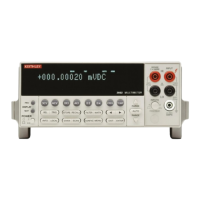Front Panel Operation
2-65
2.8.1 Burst mode
The burst data acquisition mode maximizes the reading rate
of the Model 2002. Burst mode consists of two distinct phas-
es:
• Acquiring raw readings (A/D counts).
• Post-processing the raw readings by applying calibra-
tion constants and storing the resulting readings in the
buffer.
In burst mode, the Model 2002 acquires 4.5-digit readings at
2000 readings/second. The post-processing takes about
2msec/reading. If any filter or math operations are enabled,
the post-processing time is longer. To make this reading rate
possible, certain tradeoffs are made with the unit’s function-
ality, as described in the following paragraph.
Configuring the unit for burst mode
Before burst mode can be enabled, the following changes
must be made to the present instrument configuration:
• Select a valid measurement function for the burst mode,
as listed in Table 2-30.
• Select a fixed range for the expected signal, or choose
autorange to let the instrument select a fixed range when
burst mode starts.
• Set the trigger event source in the measure layer to
immediate, external, trigger link, or timer.
• Disable any “multiple displays”.
• Disable scanning.
Table 2-29
CONFIGURE DATA STORE menu structure
Menu item Description
Burst-mode
Data-group
Full
Compact
Control
Fill-and-stop
Pretrigger
Percentage
Reading-count
Event
Continuous
Never
Timestamp
Type
Relative-Time
Real-Time
Format
Absolute
Delta
Clear-all
Count
Enter-count
Use-trigger-model
Feed
After-calc
Before-calc
None
Acquire 4.5-digit readings at 2000 readings/sec and store in buffer.
Select data types to store in buffer.
Store reading, units, channel#, reading#, time-stamp, and status (overflow).
Store reading, units, reading#, and status (overflow).
Select type of buffer control.
Fill buffer with readings and stop.
Wait for pretrigger event; store before and after readings.
Enter percentage of stored readings before trigger.
Enter count of stored readings before trigger.
Select source for pretrigger event.
Store readings in buffer continuously.
Readings are not stored.
Configure timestamp:
Check or change type:
Reference timestamp to relative time.
Reference timestamp to real-time.
Select timestamp format:
Reference each timestamp to the first buffer reading (relative), or to the time and date (real).
Reference each timestamp to the previous buffer reading.
Clear all stored readings and buffer statistics.
Select buffer size.
Enter number of readings to store.
Use (finite) measure count from trigger model.
Select type of reading to store.
Store readings after math calculation.
Store readings before math calculation.
No readings are placed in the buffer.

